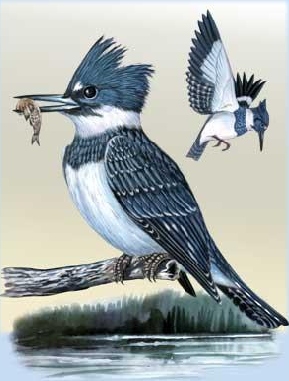|

Medium kingfisher, distinct,
bushy crest, white collar, and large, black dagger-like bill. Upperparts
are blue-gray and underparts are white.
The male has blue-gray breast band. Legs and feet are gray. Slow direct
flight with erratic pattern.
Hovers above water to search for prey.
|
BELTED
KINGFISHER
Ceryle alcyon
CORACIIFORMES
Kingfishers (Alcedinidae)
Range and Habitat
Breeds from Alaska eastward across southern Canada and south throughout
most of U.S. Spends winters on the Pacific coast north to southeastern
Alaska, and throughout the south, north to the Great Lakes and along
the Atlantic coast to New England. Preferred habitats include rivers,
lakes, and saltwater estuaries.

SOUND: "rattle"
Belted Kingfishers have been known to share their tunnels
with swallows. The swallows dig out small rooms tucked
in the tunnel walls.
To avoid being eaten by hawks, they will dive into the water.
Human activity, such as digging gravel pits and building roads, have
created banks where they can build nests and
expand their breeding range.
A group of belted kingfishers are collectively known as a "crown"
and a "rattle" of kingfishers.

The Belted Kingfisher has a range that is large, reaching
up to 14 million kilometers. The population of the
Belted Kingfisher is thought to be more than 2 million individual birds.
The Belted Kingfisher can be found in many countries in the Caribbean,
Central America and North America.
The population of the Belted Kingfisher has not significantly decreased
in the last ten years. As a result, this bird has a
current rating of Least Concern. The Belted Kingfisher
previously had a rating of Lower Risk in 2000.
|